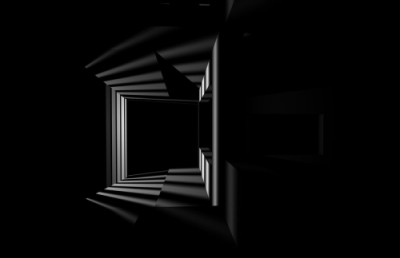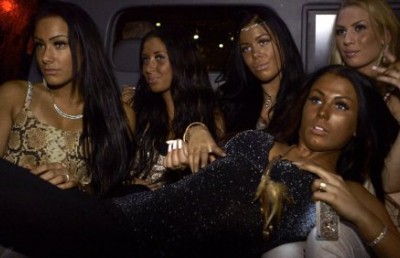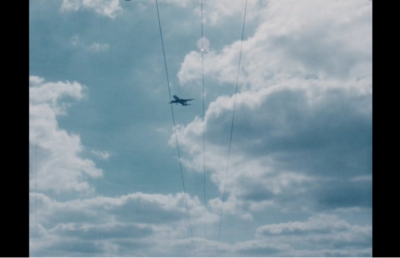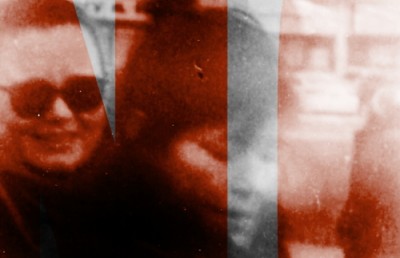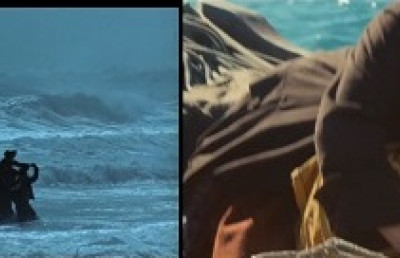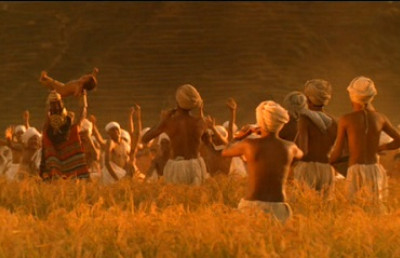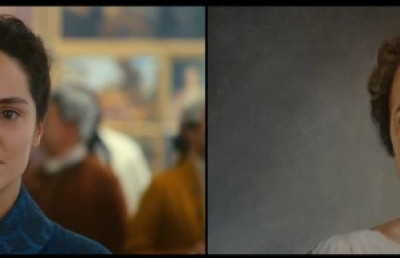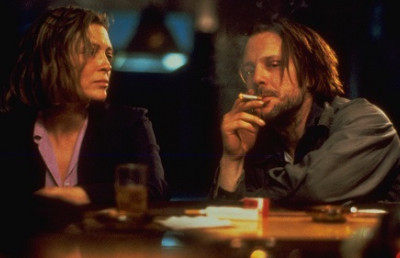“Uncontrollable Misinterpretations”: An Interview with Adán De La Garza
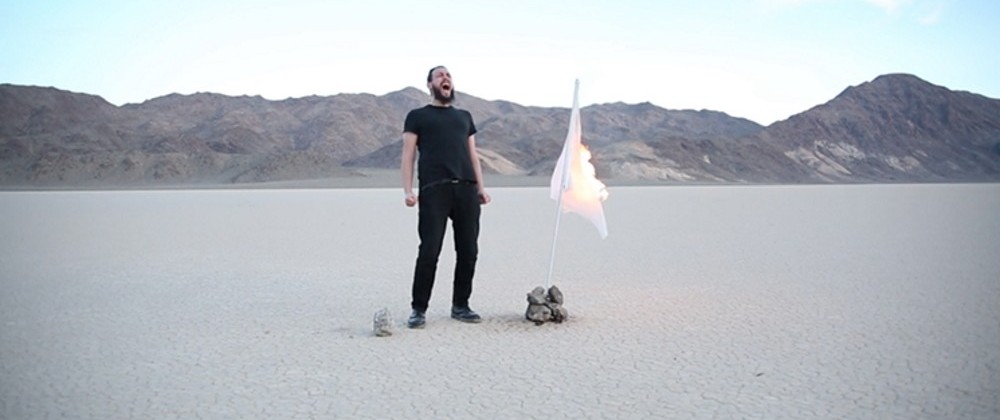
This text is presented as part of the ÉMERGENCE series, organized and presented by la lumière collective, in collaboration with the online journal Hors champ and Offscreen
Adán de la Garza is an artist based in Denver, Colorado and he is currently an anonymous member of the curatorial Collective Misnomer. His work incorporates performance, sound, photography, and video and is made with a strong punk ethos. He embraces various DIY strategies and distribution modes including handmade zines, cassettes, and lathe cut 7 inches. Adán and I first met in Toronto in 2014 when Nothing to See Here (a collaborative art project with Christina Battle) presented two curated programs, namely, Loud!!!, a program of moving image works in which the sound component of the work is prioritized, and Denver ≥ Denver, a screening of Denver-based artists. We became friends over a mutual obsession involving found 35mm photographs rescued from abandoned cameras. In 2017, in the spirit of cultural exchange, I brought What a Time to Be Alive, a screening of Toronto-based artists, to Denver. This interview is an extension of these cultural exchanges. It was conducted over video chat and collaboratively edited into its current form.
—-
CE: How did you begin making art?
AdlG: In middle school, I was placed into a black and white photography class that rotated between three different subject matters: photography, how to play card games, and stagecraft. It was basically a course for delinquents who didn’t sign up for classes on time. In stagecraft, I built sets for plays that would never happen since we were in the last term and I hate card games. It wasn’t until my twenties that I actually began consciously pursuing art. It was something that I gradually kept doing more and more.
I was introduced to punk and metal subcultures early on. Skateboard magazines, MTV, comics, and Nickelodeon were my actual introduction to art. I originally thought I would become a skateboard photographer. When I was a teenager, my friends and I began making videos emulating the stunts performed on Jackass. We wanted to make skate videos, but none of us could really skate. This definitely laid the foundation for my interest in video and incorporating elements of absurdity into my art practice. These videos currently exist in a video zine called We weren’t bored (2014).
CE: You can definitely see the roots of extreme performance in your work. Do consider Jackass to be performance art?
AdlG: I think of it as art in the same way that I think Dada is art. I once co-taught a class called From Dada to Jackass with my now partner Jenna Maurice. There is a clear lineage from performance art to Jackass and it is possible to trace contemporary iterations of performance art from Jackass. Johnny Knoxville in a flame retardant suit covered in steaks once grilled himself. While tasting the fruits of his labour, he famously proclaimed: “This performance art is for the birds.” In the same way that Dada was anti-art, Jackass was a rejection of art and Bourgeoisie culture. Also, the last Jackass movie opened at the MoMA.
CE: Was Come Steal My Art (2009), an exhibition where you invited people to come and attempt to steal your artwork, your first “real” performance? Was any of the work for sale or was it only available to be stolen? Given the cost associated with art production, did you manage to make any money from the show?
AdlG: It unintentionally was my first performance but it incorporated photographic prints, stickers, zines, buttons, screenprints and it was one of the last things I did in Arizona before I moved to Colorado for graduate school. It was an art show, but it was also a going away party where I was hoping to playfully give away artworks to friends. None of the art was for sale. The show received some media coverage and I didn’t know most of the people that ended up coming. I did attempt to prevent people from actually stealing the work, but everything was gone within thirty minutes. I had even printed a sign with rules, but someone stole that too. I had somehow naively assumed I could control the chaos. A lot of friends ended up coming after all of the work was gone. There was a donation jar and it ended up being one of my most profitable exhibitions. If you include labour (or my student loans), I didn’t break even; however, that exhibition showed me the potential of performance.
CE: The performance came at a time when people were engaging with discussions around pirating videos and music. Was this piece a response to these ideas?
AdlG: Napster and other peer-to-peer were heavily responsible for my access to art, cinema, and music. The show was a bit of a cosmic debt, given that I am now militant about paying and receiving artist fees. I still stream a lot of videos and music. At the same time, I try to support artists in other ways. This is something that everyone currently navigates and should reflect upon.
CE: In your performance, I have a horrific fear of giving up on art and becoming a businessman (2010), you created piñata’s of yourself in a business suit and remixed the sounds of them being hit by audience members with umbrellas. Why umbrellas? Were you influenced by Tadanori Yokoo’s Made in Japan (1965), a piece in which Yokoo declares his death as a “commercial” graphic designer through the image of a man in a business suit hanging from a noose while holding a rose in his hand?
AdlG: I bought all ten umbrellas at the same time, and thought it was an item all business people came equipped with. I also thought they would be a funny object to strike the piñata’s with. I’m not really familiar with Tadanori Yokoo’s work but I struggle with being an artist within a capitalist framework. That delicate balance between making your own work and making a living.
CE: You have recently given up working in academia. In your performance video Arbitrary Self Improvement (2014), you attempt to develop a set of skills that have no practical purpose in everyday life. Do you feel trapped by your skillset as an artist?
AdlG: Academia kinda forced my hand there. I held a lot of side jobs over the six years when I was adjuncting, and they all had to be temporary or flexible enough so that I could fit in my teaching schedule each semester. It’s really difficult to exist solely on what they pay adjunct professors and at a certain point I realized that I was going into debt by trying to continue to teach. So I made the decision to seek employment elsewhere. I would love to teach again but I just can’t afford to.
I eventually landed a job at a non-profit bike share that, unfortunately, dissolved last month. I worked as a bike mechanic and a truck driver delivering bikes throughout the city. It was an interesting transition and I encountered a handful of academics who I could only explain as being “embarrassed for me” for having a job that required physical labor. This work environment was way more radical than any academic setting that I have ever found myself in, and it paid substantially better. It also provided me with health insurance, unlike many adjunct positions. My coworkers at the non-profit were also more supportive of Collective Misnomer than most of my academic peers that were actively studying art. The struggle to maintain an academic title is often unhealthy.
I don’t know that I feel trapped by my own skillset, but I worry about it. In the arts, people often feel useless because they spend time building up a skillset that largely doesn’t produce a consistent income. I really hate the idea of trying to equate my self-worth to how much I make, or the job that I have. I’m currently unemployed, so reach out to me if you would like to see my resume.
CE: This is starting to feel like a job interview, let’s get back to discussing your work. In Time Spent Pondering the Absurdity of Being Censored While Talking About Being Censored (2011), you edit out all of the words in a response to being censored by Galleries of Contemporary Art University of Colorado. They pulled your “piñata performance piece” [I have a horrific fear…] from a sound art show due to “uncontrollable misinterpretation.” What do you think this means?
AdlG: I have never had this confirmed since no one from the gallery actually told me, but through the rumor mill, I heard that someone had complained thinking that the piñata’s were lynched businessmen. The gallery was situated in the lobby of a bank building with lots of windows, so I assume it was one of them who complained.
Is a piñata of myself in a suit offensive? Their letter focused on the idea that they couldn’t provide an explanation to every person passing by, hence they had to remove the work. I tried, but I just couldn’t see where they were coming from. It also felt uncourageous and lazy. Does this mean that all of the other work that remained in the show was understood by those who passed by, or that it was “safe” enough to be impervious to misinterpretation? Or was the gallery simply worried about offending potential donors?
CE: Have any of your other work been censored?
AdlG: Not intentionally. I’ve definitely been to galleries and seen my work installed improperly or off entirely. Perhaps they couldn’t find the remote?
CE: Was it an intent to mimic the aesthetics of the supercut? In particular, I am thinking of Absolutely No Words (2011), a video in which the words have been removed from wrestlers’ smack talk, leaving them only gasping for air.
AdlG: In 2011, I wasn’t familiar with the concept of a supercut. I was focusing more on procedural compositions and self-censorship.
CE: But, of course, your collaboration with Canadian moving image superstar Christina Battle, it’s been this way from the start (2015) is explicitly a supercut.
AdlG: Yeah.
CE: The piece uses pop iconography and news footage to recreate Charles Bukowski’s Dinosauria We (1992). Why Bukowski?
AdlG: We were introduced to the text through the MF Doom song Cellz from the album “Born Like This.” The text resonated with the environmental anxieties that Christina and I both share. We created the work at an artist residency in Mexico City and spent days watching news feeds. At the time, we were also thinking about how celebrities had become a form of news commentary or another way in which people receive information.
CE: How did your collaboration with Nicholas O’Brien on the self-explanatory Shadow Puppets in Front of Paintings (2012) come about?
AdlG: We were in graduate school together and are still super close. My favorite is the one at the Art Institute of Chicago where a little girl was inspired to make her own shadow puppets. The inspiration for the piece came at an art show where Nicholas and I witnessed people interacting with non-interactive art. We thought that we would take this to its logical conclusion, the most non-interactive form of art, painting.
CE: Noise Karaoke is a series of moving nonsensical syllables, inspired by Cabaret Voltaires but made for your local karaoke bar. I once circuit bent a plug-and-play karaoke machine and the result was quite similar. Glitched text on the screen with broken interpretations of Nickelback’s How You Remind Me and Alicia Keys’ Fallin’. How did you generate the text for your version?
AdlG: I was making up songs that were Dada inspired. I was looking at karaoke as a group activity that can unify based on a communal action. It’s democratic in the way that people have to embrace singing poorly. The very nature of karaoke is that you need to be bad, and Noise Karaoke inherently makes everyone bad, meaning perfect. I had envisioned these videos as a way to get an entire room to embrace yelling (and whispering) nonsense and free interpretations of sound. For instance, there is no right way to whisper “thwweeeerRRrmmp.” I have performed them a handful of times, mostly with The Flinching Eye Collective, and it’s always been a really enjoyable experience. The audience is usually somewhere between 10 to 30 people but we once performed at The Biennial of the Americas with an audience of few thousand people, mainly families and live music enthusiasts. From the stage, it literally sounded like a few thousand people all booing. We had friends in the audience and they said people really got into it.
CE: Are you still working on my personal favorite of your projects, Lurkin’ Hard, a zine series of images consisting of images found on 35mm film from used cameras?
AdlG: Lurkin’ Hard is ongoing, but it has been on hiatus for a few years since processing film has become super expensive. At this point, I have a garbage bag full of 35mm film to process, so smash that donation button at the bottom of the page if you want a copy.
CE: Another zine Key Phrase (2018) was a collection of problematic Duolingo translations. I have been slowly learning French through the app and haven’t discovered any truly offensive phrases other than those that reinforce slightly humorous stereotypes like “Les Français aiment les baguettes.”
AglG: Yeah the stuff I was finding in Duolingo for Spanish was unquestionably fucked up. For instance:
“It is not your land.”
“I never make food for my children.”
“We do not think.”
“You have no culture.”
I’ve got a whole folder of screen grabs with phrases that are really questionable. I’ve recently reactivated my account and it seems to have changed. Back then it seemed like at least 25% of the translations were problematic.
CE: Your most recent work, Protest Etiquette (2020) returns to extreme performance art. With a burning molotov cocktail balanced on your head, you walk across a rocky desert landscape. Is it possible to fix systemic racism or other forms of injustice while being polite?
AdlG: It requires a wide array of techniques, many of which are not polite. Politeness is a form of non-acknowledgement. There needs to be a certain level of infringement of order for people to convey the seriousness of the matter. While I think people can be civil and deliver a message, not everyone has an institutional ear they can whisper into. In this case, more extreme methods become the only option. Empathy is hard to enforce. I think it’s important to value a whole spectrum of tactics employed to implement societal change. The activist with a megaphone isn’t the only way for a person to be politically active. As long as the work has the same long term goals, I think it is valuable.
CE: Can you talk about the role the landscape plays in Protest Etiquette?
AdlG: It was shot in Death Valley in a place called the Devil’s Golf Course. The rocks there are actually jagged salt crystals which form an intricate system similar to coral. Deep under the surface there is actually water. Walking on them, even without a burning molotov on your head, is difficult at best, which further adds to the tension of the piece. They are also really beautiful. I find desert landscapes incredibly seductive and have used them in other work including Adding Sun (2017), a piece which documents sunlight burnt onto records using a magnifying glass, and Giving myself a reason to scream but not cry (2015-present). All landscapes are political if you look at their history. The landscape is a really well established tradition in art that often has a politic that I don’t necessarily agree with. I see them as a gateway to reach people who may not engage with or who avoid political work. That is, the landscape is a gateway to a more politicized conversation.
CE: In another collaboration with Battle, five states of freedom (2013-2016), you reactivate abandoned military sites. How difficult was it for you to track down these abandoned sites? How did you choose the intervention to perform at each site?
AdlG: There are entire databases devoted to abandoned military sites, nuclear silos, and other unusual and off-grid sites in the US. The Center for Land Use Interpretation is an amazing resource that we used to find many of the sites that we documented. The southwest is littered with these sites since the military does not have any concept of what a desert ecology should look like and assume it is just dead space…same reason they drop nuclear bombs there. If you can’t farm on it, blow it up.
The project is largely about the residue the military industrial complex leaves behind. Not only the physical residue, but also the chemical and biological. At each site, we were trying to equate a visual cue with the history and toxicity of that space. These locations have been deemed “safe” to be around but their history is toxic. There are so many heavy metals and chemicals just deteriorating into the soil beneath and around each bunker. The fireworks we selected were chosen to visualize some element of the sites history or current state. For instance, five states of freedom #5 is about fifteen miles outside of Denver at a site so reckless with their waste that the FBI actually raided them. Upon shutting down, the land was turned into a “wildlife refuge” but now new suburban developments are literally being built on the edge of that contaminated land. We used fireworks called “flashers” that burn hot and strobe, illuminating the area in bright retina etching bursts while leaving the ground scorched.
CE: Giving myself a reason addresses political burn-out, self-care and the seeming ineffectiveness of political change. Since you began making this work, the United States has erupted into protest. Do you still feel the same way or have you developed a newfound optimism?
AdlG: In some ways I do, but I am also very concerned with finding a way to get an oppressive system to listen. At a bare minimum, you need a governing body that will listen in order for there to be political change. I have a hard time calling my view optimistic because of the circumstances it took to mobilize it: unnecessary deaths, mass unemployment, and a preventable pandemic. Why do we always witness change through the lens of tragedy? I want a governing body that has the ability to listen to its citizens, make quick direct adaptations, and preemptively take actions that preserve all life.
CE: In a one version of the piece, you scream while a white flag burns. Why did you choose a white flag and not a more loaded symbol, for instance, a confederate flag? At the very least, it would be one less confederate flag in the world.
AdlG: A white flag is a sign of treaty and/or peace. It is a symbol of compliance, and through burning it, it becomes a sign of not giving up or giving in. While I support the burning of the confederate flag, it is a very limited gesture with a specific history. For this piece I wanted to take a broader stance.
The performance with the white flag took place on The Racetrack Playa in Death Valley, where there are rocks that slowly move around the landscape. If these rocks are able to move, then surely ideas can. The rocks usually leave trails, but when I got there they had been erased due to rain which, if we are willing to stretch this metaphor, points to preserved political stagnation. Either way, contemporary political change is slow moving. Those rocks will move again, whether we bear witness or not.
CE: In Methods for Composing Random Compositions (2012), you use everyday objects to perform music that, often humorously, incorporates elements of random chance. All of the sounds are generated by the objects and the performance lasts as long as the objects generate sound. Many of the objects share the explosive qualities of sonic warfare. What is the role humour plays in navigating a concept such as sonic warfare? Is humour a political weapon?
AdlG: I struggle with using humour in my work as it has recently been utilized as a catch all for being able to say anything. That is, if you find this offensive…get a sense of humor. Humour is complicated. It can be an amazing sledgehammer. It can be a starting point, allowing people a way into the work, but it can also be an ending point for people who aren’t invested in further inquiry. People have often read Methods for Composing Random Compositions as only funny and in this way I feel it has failed.
The toys used in the video are microcosms of war. They are training tools for familiarity building. The bomb bags literally have images of tanks and bombers on them. Similarly in five states of freedom, we used fireworks, consumer grade explosives marketed to kids and “patriots.”
CE: A Space for Reflection (2012) through the use of mirrors, forces the viewer to reflect on the sound of Long Range Audio Deterrents (LRADs) which sonically infiltrates the space through rotational, directional speakers. Can you speak to the connection between noise music, which people engage with as a form “entertainment,” and sonic warfare, a form of psychological torture?
AdlG: Noise music, to me, is just another genre of music, like metal or country. One of the things that distinguishes noise from other genres is that noise music demands people’s engagement. It is not a passive listening experience and is pretty difficult to ignore. It is also embodied and disruptive, and not for most people.
In A Space for Reflection, I am using the consumer grade version of the directional speaker used in LRADs. Directional speakers throw sound in a unique way. In the installation, the sound bounces off the mirrored surfaces filling the space, and since the speakers rotate, the sound moves in a way that can be disorienting or pleasing depending on your musical taste. In my work, the sound of the LRAD is changed into something the audience can actually engage with. In general, LRADs are not intended to fill space, but to hone in on specific people.
Two main differences between noise music and sonic warfare are volume and duration. Moreover, in sonic warfare there is a power dynamic that forces one to be subjected to another’s agenda. While sound does have an inherent imperialistic quality, in that it is impossible to not experience it entirely on some level, the listener isn’t held captive by my installation and I have no intention to harm them. The LRADs sheer volume can permanently damage someone’s hearing in a matter of seconds and my piece could never get that loud.
CE: What are you currently working on?
AdlG: I’ve been shooting a project over the past few years which deals with the desertification of the earth, climate migration, and societal collapse. Basically, experimental speculative fiction. The video is episodic, with three or four chapters, and takes place in the future. One of the chapters is about the 1% realizing that Mars won’t be an extension of the wealthy’s luxurious lifestyle, and is actually inhabitable or is just as hostile as the earth is going to become due to climate change. The production of the video has been put on hold due to Covid-19. I had an artist residency and a handful of travel plans for shooting disrupted due to the pandemic. The current sociopolitical situation has informed the film. For instance, deforestation and its connection to out-breaks. I had to step away from the project since the research started to be too draining as I was witnessing elements of this sci-fi dystopia happen in real-time.
A positive element of the current situation is that I have had time to revisit AYA and to revamp a few other projects. If you are interested in trading zines, send me an e-mail.
CE: Any upcoming online Collective Misnomer screenings we should know about?
AdlG: The upcoming screenings are all online, at least for the remainder of the year. They have been programmed by unanonymous members and the programs mainly consist of work by their friends and active members of their community. A few highlights include programs by Jared Steffensen, Nika Kaiser, Raven Chacon, and Lydia Moyer. Basically, it is all friends of friends.
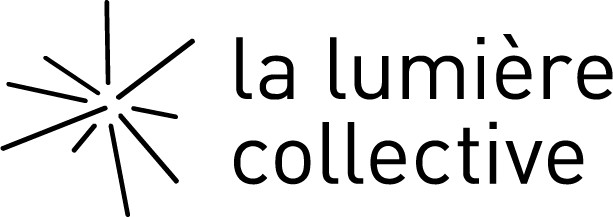
By night, la lumière collective is a microcinema that projects films, videos and expanded cinema produced by local and international artists. By day, la lumière collective is an artists’ studio and residency space with multiple resources for working and experimenting with various moving image media. The collective is led by local artists and curators who believe in creating cinematic works and spaces on a human scale. We facilitate events to bring people together. We create links to help promote and revitalize cinema.
La lumière collective is rooted in the local, the physical, the here and now.
In this time of virtual connections and physical distancing, we have transformed our projection space into a virtual space, while maintaining local connections.
EMERGENCE is the adapted online version of the practical activities planned by la lumière collective. Online love in the time of COVID.
Instead of simply downloading the films and videos available online, la lumière collective has selected one work by each artist and asked that a local writer be involved with each work.
EMERGENCE is a new combination, a local connectedness, a commitment to counter separation.
We look forward to seeing you on the other side.
EMERGENCE is presented with the support of the Canada Council for the Arts.


